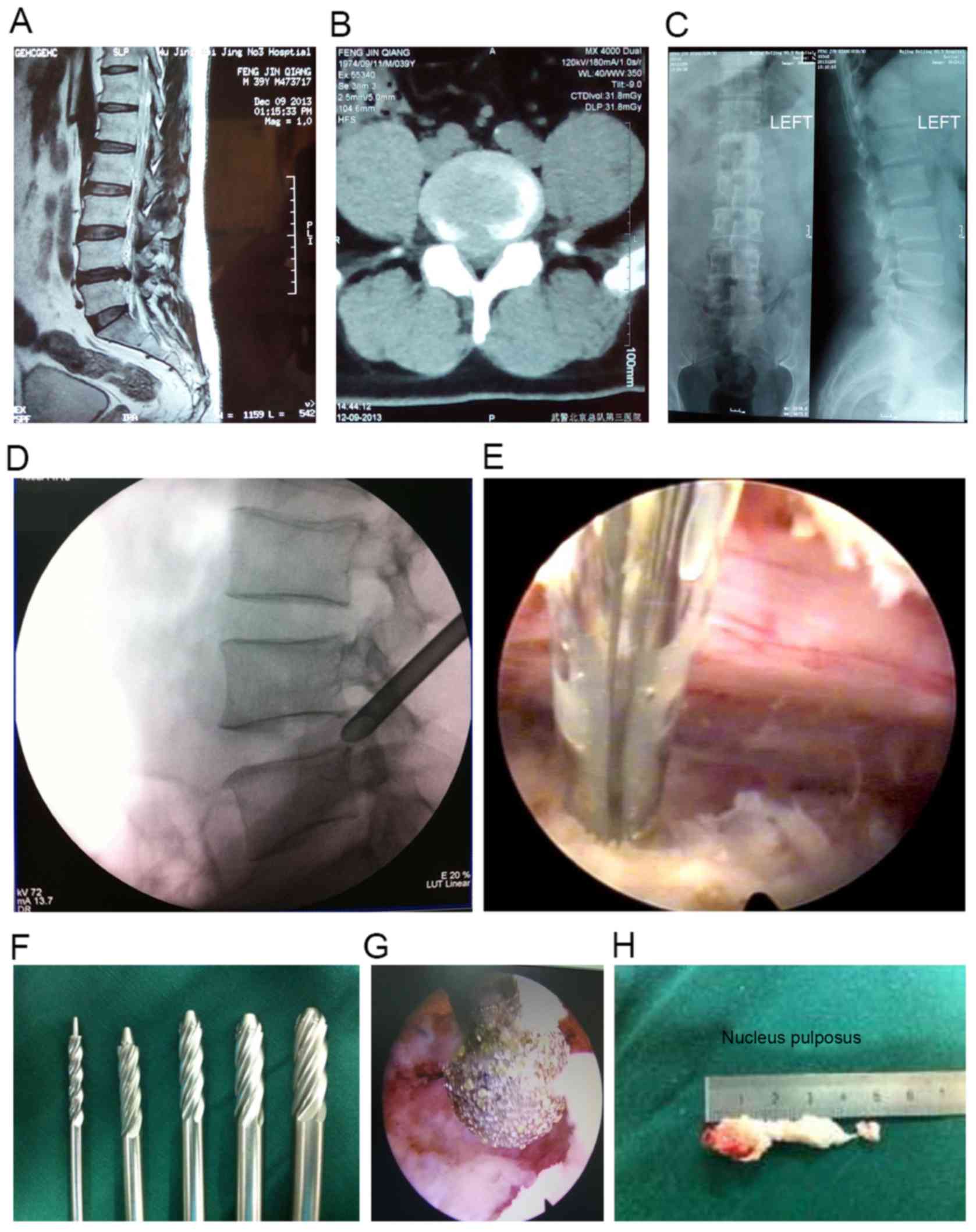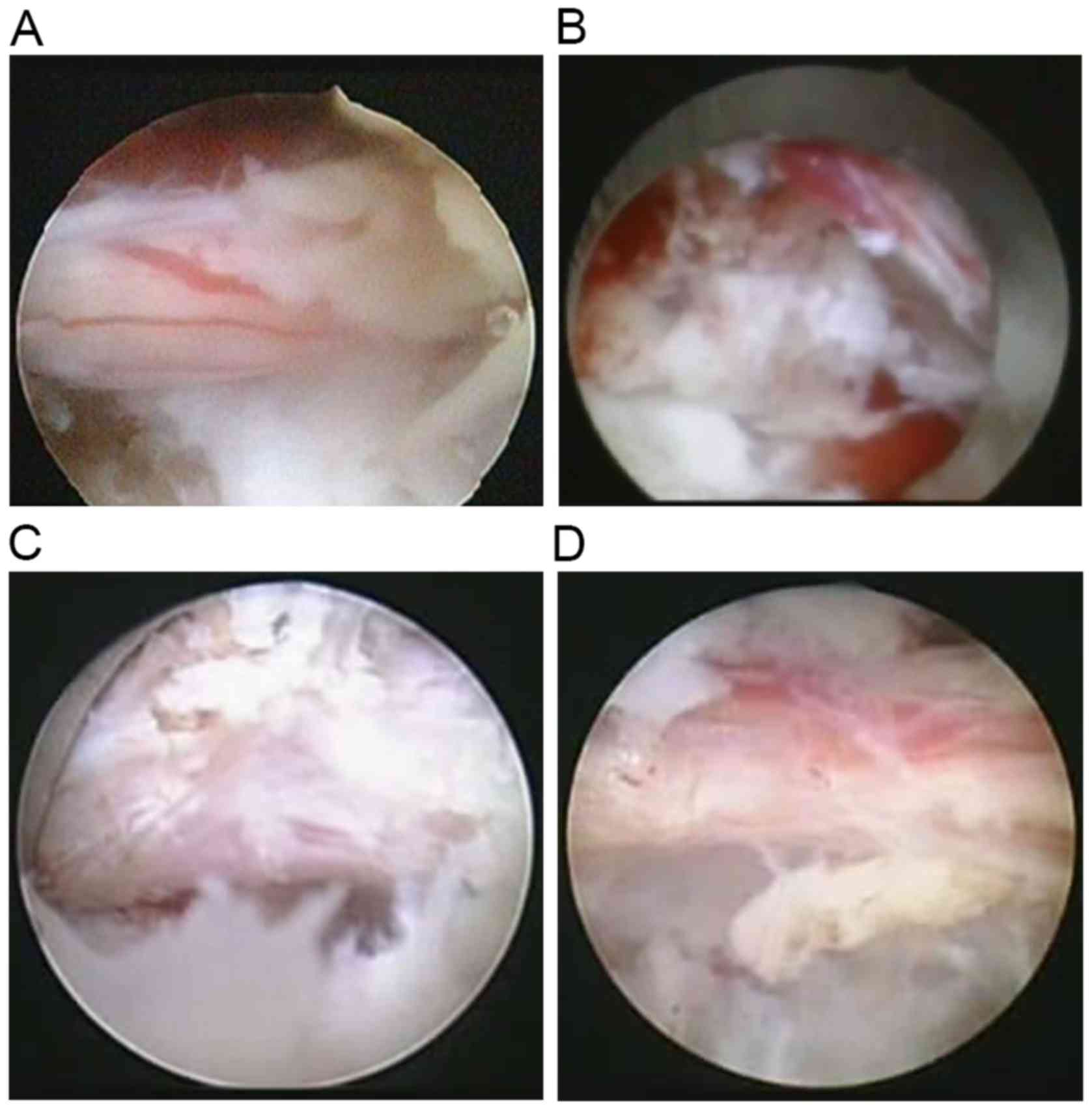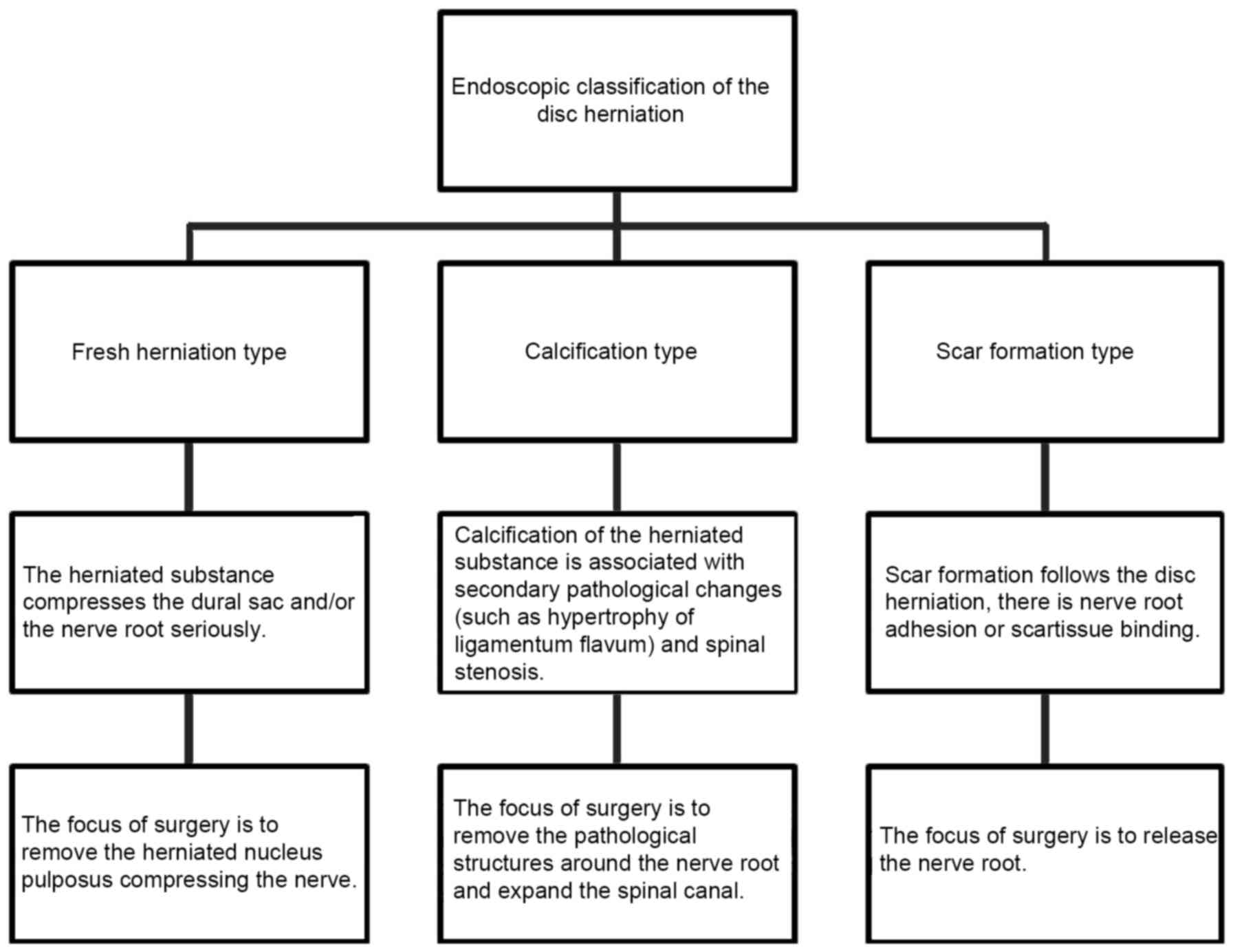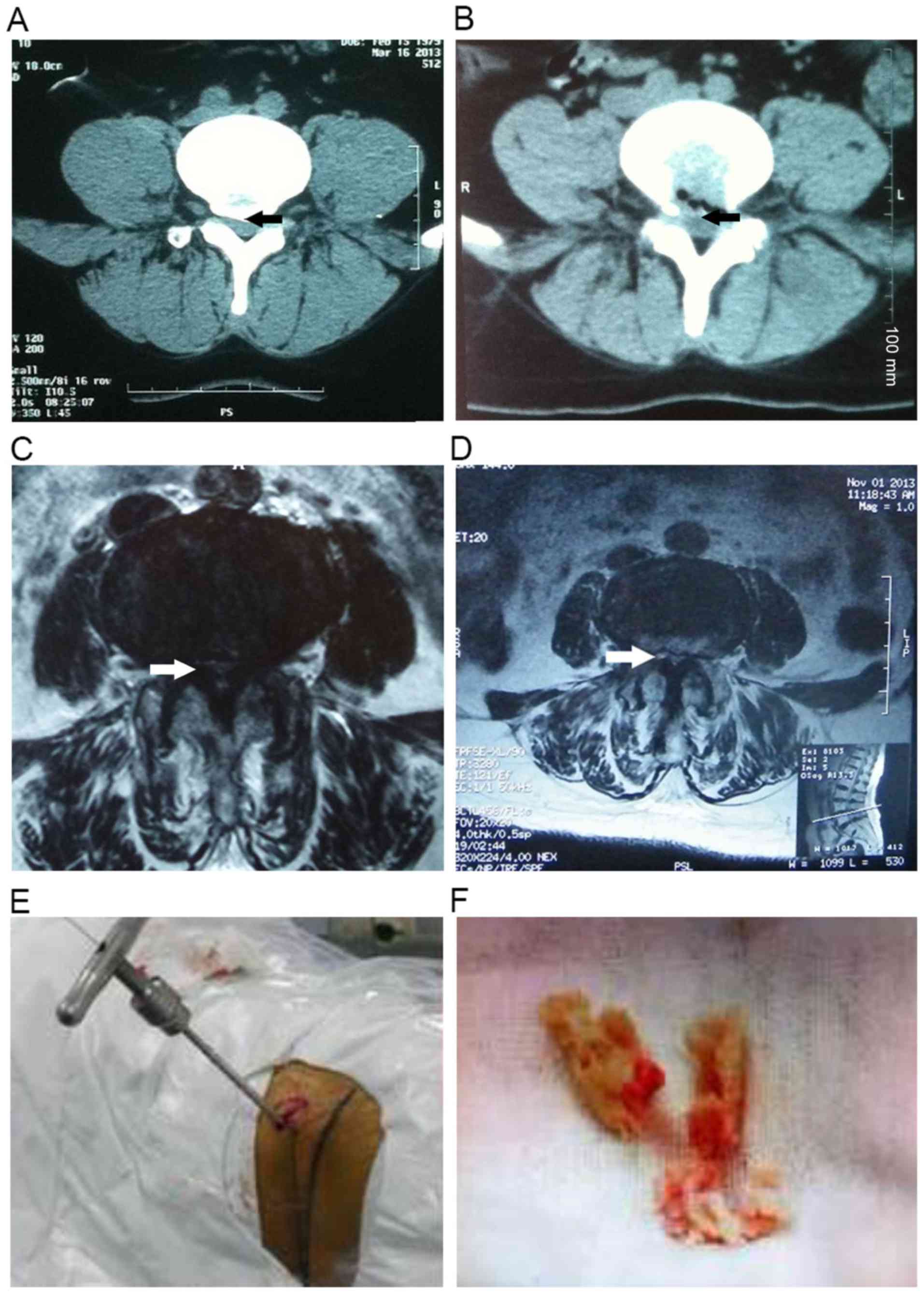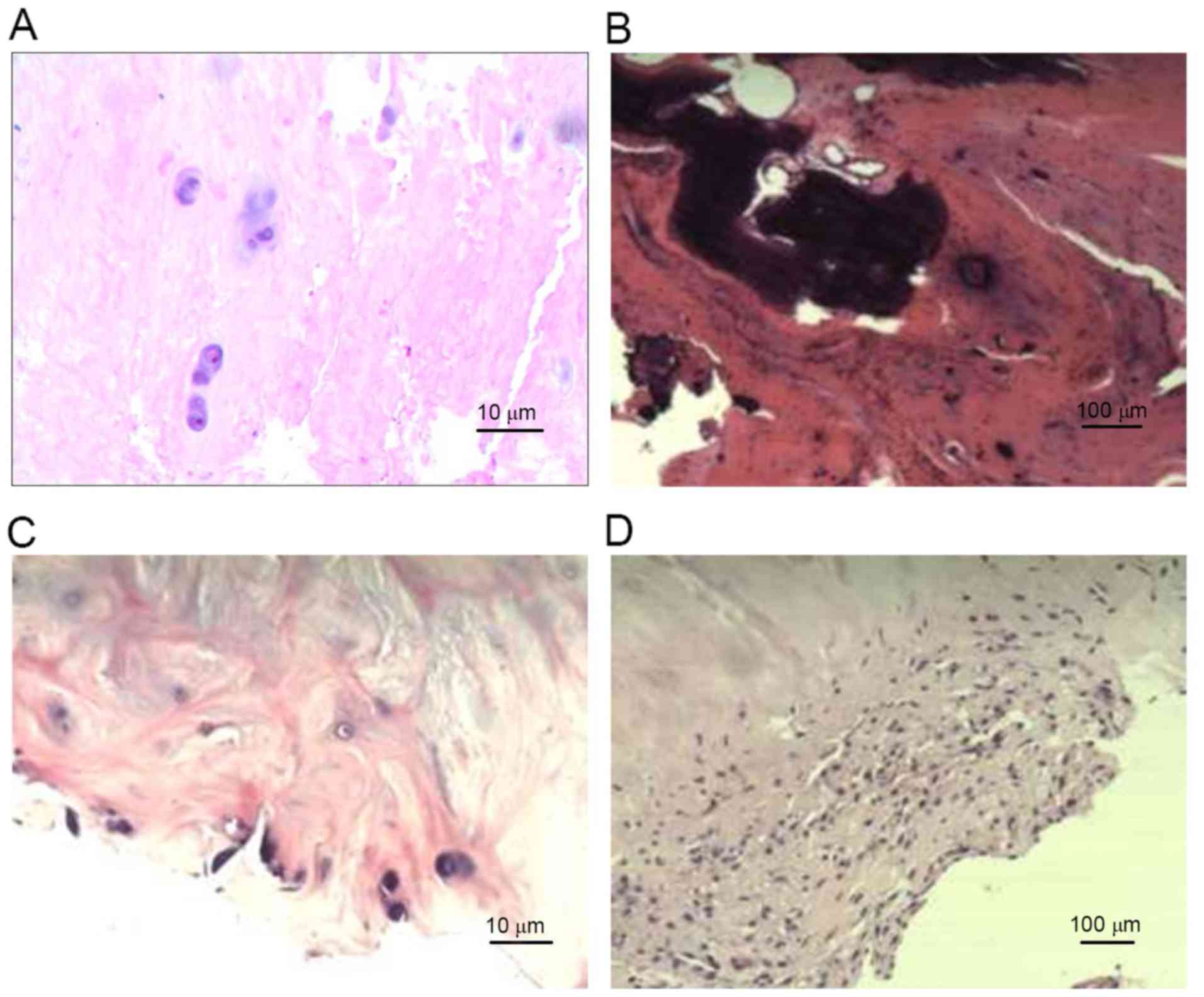|
1
|
Gibson JN, Cowie JG and Iprenburg M:
Transforaminal endoscopic spinal surgery: The future ‘gold
standard’ for discectomy?-A review. Surgeon. 10:290–296. 2012.
View Article : Google Scholar : PubMed/NCBI
|
|
2
|
Schubert M and Hoogland T: Endoscopic
transforaminal nucleotomy with foraminoplasty for lumbar disk
herniation. Oper Orthop Traumatol. 17:641–661. 2005.(In English,
German). View Article : Google Scholar : PubMed/NCBI
|
|
3
|
Iprenburg M and Godschalx A:
Transforaminal endoscopic surgery in lumbar disc herniation in an
economic crisis-the TESSYS method. US Musculoskeletal Review.
3:47–49. 2008.
|
|
4
|
Kim HS, Ju CI, Kim SW, Kim JG, Lee SM and
Kim BW: Minimally invasive percutaneous endoscopic 2 levels
adjacent lumbar discectomy through 1 portal skin incision:
Preliminary study. Asian J Neurosurg. 10:95–101. 2015. View Article : Google Scholar : PubMed/NCBI
|
|
5
|
Choi G, Modi HN, Prada N, Ahn TJ, Myung
SH, Gang MS and Lee SH: Clinical results of XMR-assisted
percutaneous transforaminal endoscopic lumbar discectomy. J Orthop
Surg Res. 8:142013. View Article : Google Scholar : PubMed/NCBI
|
|
6
|
Knight MT, Jago I, Norris C, Midwinter L
and Boynes C: Transforaminal endoscopic lumbar decompression &
foraminoplasty: A 10 year prospective survivability outcome study
of the treatment of foraminal stenosis and failed back surgery. Int
J Spine Surg. 8:212014. View
Article : Google Scholar
|
|
7
|
Anichini G, Landi A, Caporlingua F,
Beer-Furlan A, Brogna C, Delfini R and Passacantilli E: Lumbar
endoscopic microdiscectomy: Where are we now? An updated literature
review focused on clinical outcome, complications and rate of
recurrence. Biomed Res Int. 2015:4178012015. View Article : Google Scholar : PubMed/NCBI
|
|
8
|
Milette PC: Classification, diagnostic
imaging, and imaging characterization of a lumbar herniated disk.
Radiol Clin North Am. 38:1267–1292. 2000. View Article : Google Scholar : PubMed/NCBI
|
|
9
|
TESSYS technique (transforaminal
endoscopic surgical system). http://www.joimax.com/us/products/endoscopy/tessys/TESSYS_concept.phpAccessed.
Jan 2–2015.
|
|
10
|
Nellensteijn J, Ostelo R, Bartels R, Peul
W, van Royen B and van Tulder M: Transforaminal endoscopic surgery
for symptomatic lumbar disc herniations: A systematic review of the
literature. Eur Spine J. 19:181–204. 2010. View Article : Google Scholar : PubMed/NCBI
|
|
11
|
Aitken RC: Measurement of feelings using
visual analogue scales. Proc R Soc Med. 62:989–993. 1969.PubMed/NCBI
|
|
12
|
Fairbank JC, Couper J, Davies JB and
O'Brien JP: The Oswestry low back pain disability questionnaire.
Physiotherapy. 66:271–273. 1980.PubMed/NCBI
|
|
13
|
Monticone M, Baiardi P, Ferrari S, Foti C,
Mugnai R, Pillastrini P, Vanti C and Zanoli G: Development of the
Italian version of the Oswestry Disability Index (ODI-I): A
cross-cultural adaptation, reliability, and validity study. Spine
(Phila Pa 1976). 34:2090–2095. 2009. View Article : Google Scholar : PubMed/NCBI
|
|
14
|
Macnab I: Negative disc exploration. An
analysis of the causes of nerve-root involvement in sixty-eight
patients. J Bone Joint Surg Am. 53:891–903. 1971. View Article : Google Scholar : PubMed/NCBI
|
|
15
|
Soliman HM: Irrigation endoscopic
discectomy: A novel percutaneous approach for lumbar disc prolapse.
Eur Spine J. 22:1037–1044. 2013. View Article : Google Scholar : PubMed/NCBI
|
|
16
|
Gore S and Yeung A: The ‘inside out’
transforaminal technique to treat lumbar spinal pain in an awake
and aware patient under local anesthesia: Results and a review of
the literature. Int J Spine Surg. 8:2014. View Article : Google Scholar
|
|
17
|
Kang SH and Park SW: Symptomatic
post-discectomy pseudocyst after endoscopic lumbar discectomy. J
Korean Neurosurg Soc. 49:31–36. 2011. View Article : Google Scholar : PubMed/NCBI
|
|
18
|
Ahn Y, Lee HY, Lee SH and Lee JH: Dural
tears in percutaneous endoscopic lumbar discectomy. Eur Spine J.
20:58–64. 2011. View Article : Google Scholar : PubMed/NCBI
|
|
19
|
Choi I, Ahn JO, So WS, Lee SJ, Choi IJ and
Kim H: Exiting root injury in transforaminal endoscopic discectomy:
Preoperative image considerations for safety. Eur Spine J.
22:2481–2487. 2013. View Article : Google Scholar : PubMed/NCBI
|
|
20
|
Genevay S, Atlas SJ and Katz JN: Variation
in eligibility criteria from studies of radiculopathy due to a
herniated disc and of neurogenic claudication due to lumbar spinal
stenosis: A structured literature review. Spine (Phila Pa 1976).
35:803–811. 2010. View Article : Google Scholar : PubMed/NCBI
|
|
21
|
Awad JN and Moskovich R: Lumbar disc
herniations: Surgical versus nonsurgical treatment. Clin Orthop
Relat Res. 443:183–197. 2006. View Article : Google Scholar : PubMed/NCBI
|
|
22
|
Masui T, Yukawa Y, Nakamura S, Kajino G,
Matsubara Y, Kato F and Ishiguro N: Natural history of patients
with lumbar disc herniation observed by magnetic resonance imaging
for minimum 7 years. J Spinal Disord Tech. 18:121–126. 2005.
View Article : Google Scholar : PubMed/NCBI
|
|
23
|
Parisini P, Di Silvestre M, Greggi T,
Miglietta A and Paderni S: Lumbar disc excision in children and
adolescents. Spine (Phila Pa 1976). 26:1997–2000. 2001. View Article : Google Scholar : PubMed/NCBI
|
|
24
|
Atlas SJ, Keller RB, Wu YA, Deyo RA and
Singer DE: Long-term outcomes of surgical and nonsurgical
management of sciatica secondary to a lumbar disc herniation: 10
year results from the Maine lumbar spine study. Spine (Phila Pa
1976). 30:927–935. 2005. View Article : Google Scholar : PubMed/NCBI
|
|
25
|
Yoshiiwa T, Miyazaki M, Kawano M, Ikeda S
and Tsumura H: Analysis of the relationship between hypertrophy of
the ligamentum flavum and lumbar segmental motion with aging
process. Asian Spine J. 10:528–535. 2016. View Article : Google Scholar : PubMed/NCBI
|
|
26
|
Hasegawa T, An HS, Inufusa A, Mikawa Y and
Watanabe R: The effect of age on inflammatory responses and nerve
root injuries after lumbar disc herniation: An experimental study
in a canine model. Spine (Phila Pa 1976). 25:937–940. 2000.
View Article : Google Scholar : PubMed/NCBI
|
|
27
|
Shamji MF, Allen KD, So S, Jing L, Adams
SB Jr, Schuh R, Huebner J, Kraus VB, Friedman AH, Setton LA and
Richardson WJ: Gait abnormalities and inflammatory cytokines in an
autologous nucleus pulposus model of radiculopathy. Spine (Phila Pa
1976). 34:648–654. 2009. View Article : Google Scholar : PubMed/NCBI
|
|
28
|
Wassenaar M, van Rijn RM, van Tulder MW,
Verhagen AP, van der Windt DA, Koes BW, de Boer MR, Ginai AZ and
Ostelo RW: Magnetic resonance imaging for diagnosing lumbar spinal
pathology in adult patients with low back pain or sciatica: A
diagnostic systematic review. Eur Spine J. 21:220–227. 2012.
View Article : Google Scholar : PubMed/NCBI
|















